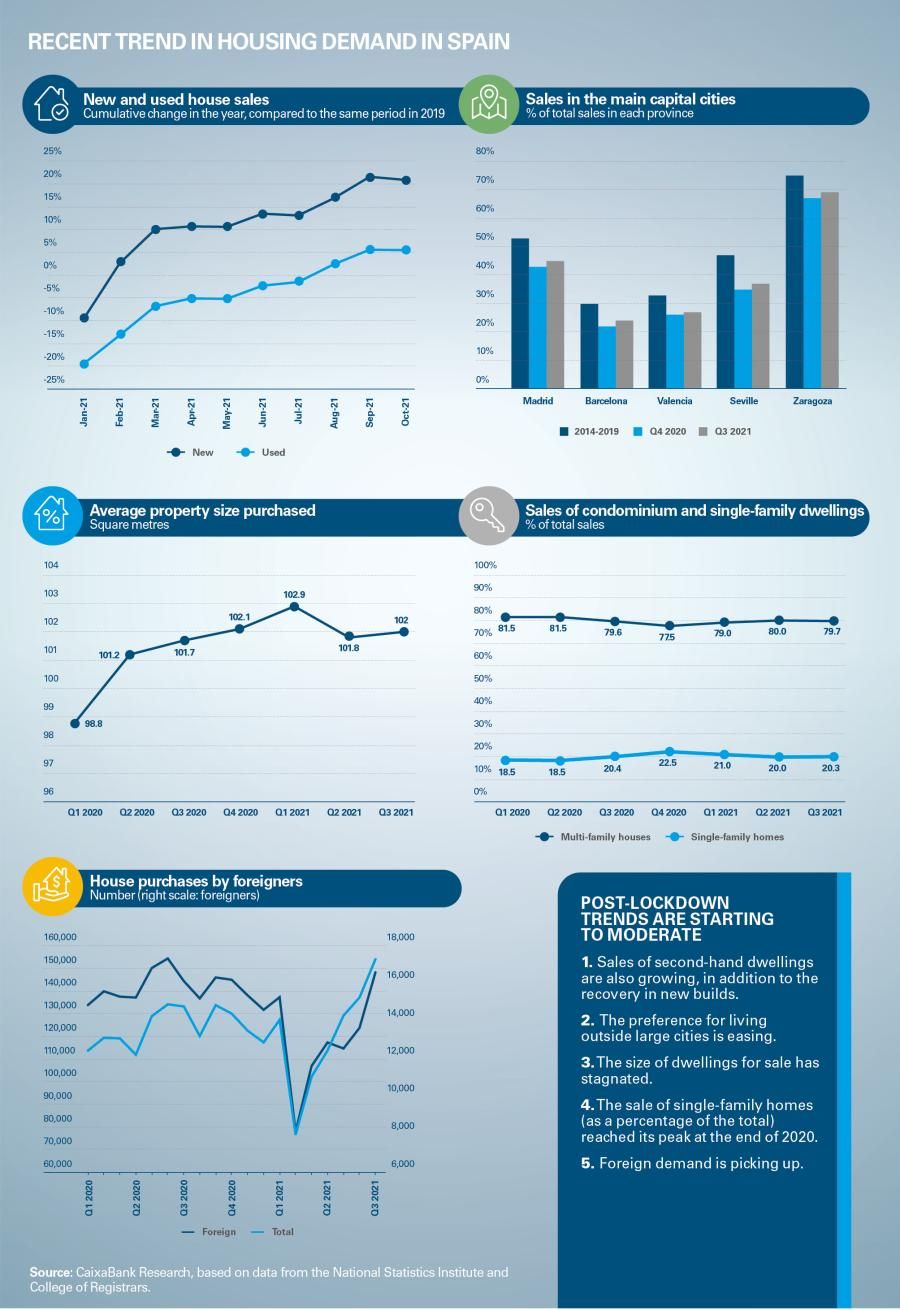Strong demand is reviving Spain’s residential market
In the course of 2021 we have seen that, in the wake of the pandemic, a misalignment has emerged in the real estate sector between a demand that has recovered very quickly and a supply that is more dependent on structural factors and therefore continues to lag behind. As a result of this misalignment, house prices have started an upward trend which may continue to some extent in the coming quarters as a result of higher production costs in the sector and problems with the supply of certain raw materials. Nevertheless, in the medium term, as new supply enters the market and tensions in global supply chains ease, prices should return to a growth rate that is more in line with the trend in household income.

Demand for housing has been one of the most positive surprises of 2021
After the historic shock of the pandemic, the situation of the Spanish economy improved notably throughout 2021. The progress made with vaccinations and the effectiveness of the measures implemented to mitigate the economic and social impact of COVID-19 have enabled activity to recover progressively. We expect this positive trend to improve further in 2022, thanks in part to an additional boost from the NGEU funds. Our forecasts therefore predict that Spain’s GDP will accelerate, growing by 4.4% in 2021 and 5.9% in 2022.
Within this context of economic recovery, Spain’s real estate market is posting a very positive trend, especially in terms of demand. So much so that the revival in house sales is surprisingly vigorous: 468,000 transactions were completed by October 2021, a growth of 35.9% compared to 2020 and up by 8.3% on 2019. In fact, activity in the residential sector is at its highest level since 2008. A large part of this revival in demand has come from a reduction in pent-up demand and the «forced» savings accumulated during the months of lockdown and severely restricted travel, combined with highly favourable financing conditions, which make it more attractive to buy and invest in real estate assets. The residential sector is therefore on track to close 2021 with 545,000 sales in the year as a whole.
Demand for housing is above its pre-COVID levels but with notable regional differences
Across the autonomous communities, so far in 2021 we can see that the regions that have yet to regain their level of business in 2019 are those whose economy has suffered most from the consequences of the health crisis. This is particularly the case of the Canary Islands and Balearic Islands as they depend most on the arrival of tourists, where the number of house sales is more than 5% below pre-pandemic levels. The Community of Valencia and Basque Country are the other two regions where residential demand is particularly sluggish as they were markedly affected by the severe restrictions resulting from the health crisis due to their dependence on foreign demand (in the case of the former) and the sectoral composition of the region’s economy (in the case of the Basque Country).
Demand is surprisingly strong
but post-lockdown trends are already beginning to moderate
As the sector evolves towards the new normal, we are starting to see that some of the main features characterising post-lockdown demand are easing: (i) not only is there a recovery in the purchase of new builds but used house sales are also growing and are above pre-COVID levels; (ii) the preference for living outside large cities or provincial capitals is moderating (the rise in teleworking and a search for greater social distance led to interest in housing outside large urban centres);1 (iii) the size of the dwellings purchased, after increasing significantly in 2020, seems to have stagnated in Q1 2021; (iv) the sale of single-family homes (as a percentage of total sales) peaked at the end of 2020, and (v) foreign demand is recovering, much more clearly from the summer of 2021 when the success of the vaccination campaigns in Spain and throughout Europe allowed for a drastic reduction in restrictions on travel with a consequent increase in tourist arrivals.2
- 1New, more flexible forms of working are likely to eventually take hold, possibly in a hybrid format, so that a higher proportion of buyers can be expected to choose to live in a location relatively further away from their workplace, or the appeal of owning a second home is likely to increase.
- 2According to the Association of Registrars, foreigners purchased around 16,600 residences in Spain in Q3 2021, 8% more than in Q3 2019 and very close to the quarterly high of 17,300 homes reached in Q2 2018.

By 2022, the main drivers of residential demand will continue to support the sector. Firstly, the outlook for the economy as a whole is favourable (we expect GDP to regain its pre-pandemic level by then) and the labour market will maintain a good job creation rate (having reached its pre-COVID levels in 2021). Secondly, household confidence continues to rise and is already at similar levels to those recorded in 2019, according to the European Commission’s confidence indicator. Thirdly, household disposable income is already showing clear signs of recovering and a large part of the savings accumulated in recent months will also be allocated to investment in housing. In addition, household formation is picking up after the decline posted during the months of lockdown (124,000 households have been created in the past year up to Q3 2021, a very similar figure to 2019). In turn, foreign demand for housing will continue to recover as tourist arrivals increase.3 Finally, financing conditions will remain favourable (mortgage interest rates have recorded new lows in 2021) and no interest rate hikes are expected from the ECB next year.4
- 3CaixaBank Research expects 80% of the international tourist arrivals recorded in 2019 to be regained by 2022.
- 4The ECB remains confident that the factors pushing up inflation are temporary and will dissipate over the course of 2022, so monetary policy remains on track and we do not expect any interest rate hikes until 2024.
Household disposable income is already showing clear signs of recovering
and a large part of the savings accumulated in recent months will also be used for investment in housing
Fundamentals continue to support demand for housing
While demand factors remain clearly favourable, the temporary factors that have been boosting demand in 2021 will dissipate in 2022, so we expect demand to moderate
towards its pre-pandemic levels, slightly above 500,000 transactions per year.
Supply in the sector is recovering but could be hindered by shortages
Certificates of final completion (available until September) have kept up the good figures posted in 2020. So far this year, 68,593 homes have been completed, 13% up over last year and 25% over the same period in 2019. In other words, the number of new homes delivered has not only exceeded pre-pandemic levels but is at its highest rate since 2012.
It should be noted that, although positive, these figures do not reflect the current situation of the supply of new builds as they refer to developments which, in many cases, had already been started before the pandemic. On the other hand, the supply of new builds, which is much more dependent on structural factors, continues to lag behind. Between January and September, new building permits rebounded by 26% year-on-year but are still 3.9% below their 2019 level.
The misalignment between new supply and demand is a common event at this point in the economic cycle,
when uncertainty is high. However, the current situacion is not alarming
Should the current rate continue, just over 100,000 new building permits will have been issued in 2021 as a whole, very similar to the figure in 2018 and 2019. Moreover, the medium and long-term outlook for supply is still favourable, considering the strength of the factors that are driving demand and the boost provided by the arrival of the European reconstruction funds (NGEU) which, in the area of housing, will be allocated for refurbishment, in line with the ambitious environmental targets underpinning the allocation of these European funds.
Housing developments remain positive but new supply continues to lag behind
However, in recent months new dark clouds have appeared on the horizon that could hinder the recovery in supply, related to rising raw material prices and the blockages experienced by international trade. According to Eurostat data, the sector’s costs are growing by more than 12% per year and the prices of certain supplies by more than 15% (latest available data are from September). In the same vein, a recent survey conducted by the industry’s businesses, the National Confederation of Construction (CNC), shows that 75% of companies have suffered some shortage or unusual delay of wood, aluminium or steel, among other materials. Given this situation, the sector is already warning of delays in construction work and is asking for more flexibility in terms of renegotiating contracts, extending deadlines for completing projects without penalties and speeding up tenders for European fund projects.
Industry costs are rising but confidence has recovered
House prices are starting an upward trend
The general improvement in demand and the more limited capacity of developers to react and, therefore, the smaller recovery in supply, are causing a certain upward trend in house prices, particularly in the segment of new builds. Since year-on-year rates bottomed out between Q4 2020 and Q1 2021 (depending on the price indicator), prices have been on an upward trajectory throughout 2021. The most recent data available show further recovery in prices in Q3 2021 of 7.4% year-on-year (5.4% in Q2), according to the College of Registrars’ quarterly repeat house sales price index; by 4.2% year-on-year (3.3% in Q2) according to the INE’s house price index based on transactions, and by 2.6% (2.4% in Q2), according to the appraised value of free housing published by the MITMA. With this increase, house prices exceeded their pre-pandemic level in Q3 2021 (+0.5% compared to Q4 2019). This upward trend can be observed across the autonomous regions as they all posted year-on-year gains in Q3 2021. However, the degree of recovery across regions is disparate (see the chart below). Of note is the strong growth in prices since Q4 2019 observed in the Balearic Islands, Andalusia, Cantabria, Asturias and the Community of Valencia, among others, compared to other regions that have not yet exceeded their pre-pandemic levels (especially Navarre, Aragon and Castilla y León).
The increase in demand for housing in recent months
has caused prices to reverse their trend and start growing
In the short term, the dynamism of demand compared to supply and rising construction costs suggest that house prices will continue to have some upside potential. In addition, favourable financing conditions will go on supporting investment in real estate assets. However, in the medium term, taking into account the absence of structural imbalances in the fundamentals of both demand and supply, we do not expect prices to embark on any worrying upward spiral. In fact, their growth should be more in line with the trend in household income once the «champagne effect» of demand becomes more diluted, supply recovers more significantly and commodity prices moderates.5
- 5For further analysis of the upside and downside risks to house prices in the Spanish market, see the article «Measuring the downside and upside risks to Spanish house prices» in this report.
